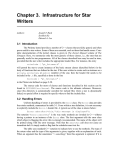Download Chapter 12. DE Domain
Transcript
Chapter 12. DE Domain
Authors:
Soonhoi Ha
Edward A. Lee
Thomas M. Parks
Other Contributors:
Brian L. Evans
12.1 Introduction
The discrete event (DE) domain in Ptolemy provides a general environment for timeoriented simulations of systems such as queueing networks, communication networks, and
high-level computer architectures. In the domain, each Particle represents an event that
corresponds to a change of the system state. The DE schedulers process events in chronological order. Since the time interval between events is generally not fixed, each particle has an
associated time-stamp. Time stamps are generated by the block producing the particle, using
the time stamps of the input particles and the latency of the block.
We assume in this chapter that the reader is thoroughly familiar with the DE model of
computation. Refer to the User’s Manual. Moreover, we assume the reader is familiar with
chapter 2, “Writing Stars for Simulation”. In this chapter, we give the additional information
required to write stars for the DE domain.
12.2 Programming Stars in the DE Domain
A DE star can be viewed as an event-processor; it receives events from the outside,
processes them, and generates output events after some latency. In a DE star, the management
of the time stamps of the particles (events) is as important as the input/output mapping of particle values.
Generating output values and time stamps are separable tasks. For greatest modularity,
therefore, we dedicate some DE stars, so-called delay stars, to time management. Examples of
such stars are Delay and Server. These stars, when fired, produce output events that typically have larger time stamps than the input events. They usually do not manipulate the value
of the particles in any interesting way. The other stars, so-called functional stars, avoid timemanagement, usually by generating output events with the same time stamp as the input
events. They, however, do manipulate the value of the particles.
Delay stars should not be confused with the delay marker on an arc connecting two
stars (represented in pigi by a small green diamond). The latter delay is not implemented as
a star. It is a property of the arc. In the DE domain, the delay marker does not introduce a time
delay, in the sense of an incremented time stamp. It simply tells the scheduler to ignore the arc
while assigning dataflow-based firing priorities to stars. A star whose outputs are all marked
with delays will have the lowest firing priority, and so will be fired last among those stars eligible to be fired at the current time.
The scheduler’s assignment of firing priority also uses properties of the individual
12-2
DE Domain
stars: each star type can indicate whether or not it can produce zero-delay outputs. If a star
indicates that it does not produce any output events with zero delay, then the scheduler can
break the dataflow priority chain at that star. This saves the user from having to add explicit
delay markers. A star class can make this indication either globally (it never produces any
immediate output event) or on a port-by-port basis (only some of its input ports can produce
immediate outputs, perhaps on only a subset of its output ports).
For managing time stamps, the DEStar class has two DE-specific members: arrivalTime and completionTime, summarized in table 12-1.. Before firing a star, a DE scheduler sets the value of the arrivalTime member to equal the time stamp of the event
triggering the current firing. When the star fires, before returning, it typically sets the value of
the completionTime member to the value of the time stamp of the latest event produced by
the star. The schedulers do not use the completionTime member, however, so it can actually
be used in any way the star writer wishes. DEStar also contains a field delayType and a
method setMode that are used to signal the properties of the star, as described below.
12.2.1 Delay stars
Delay-stars manipulate time stamps. Two types of examples of delay stars are pure
delays, and servers. A pure-delay star generates an output with the same value as the input
sample, but with a time stamp that is greater than that of the input sample. The difference
between the input sample time stamp and the output time stamp is a fixed, user-defined value.
Consider for example the Delay star:
defstar {
name {Delay}
domain {DE}
desc { Delays its input by a fixed
input {
name {input}
type {anytype}
}
output {
name {output}
type {=input}
}
defstate {
name {delay}
type {float}
default {"1.0"}
desc { Amount of time delay.
}
constructor {
delayType = TRUE;
}
go {
completionTime = arrivalTime
Particle& pp = input.get();
output.put(completionTime) =
}
}
amount }
}
+ double(delay);
pp;
Inside the go method description, the completionTime is calculated by adding the delay to
U. C. Berkeley
Department of EECS
The Almagest
12-3
the arrival time of the current event. The last two lines will be explained in more detail below.
Another type of delay star is a server. In a server star, the input event waits until a simulated resource becomes free to attend to it. An example is the Server star:
defstar {
name {Server}
domain {DE}
desc {
This star emulates a server. If an input event arrives when it
is not busy, it delays it by the service time (a constant parameter).
If it arrives when it is busy, it delays it by more than the service
time. It must become free, and then serve the input.
}
input {
name {input}
type {anytype}
}
output {
name {output}
type {=input}
}
defstate {
name {serviceTime}
type {float}
default {"1.0"}
desc { Service time. }
}
constructor {
delayType = TRUE;
}
go {
// No overlapped execution. set the time.
if (arrivalTime > completionTime)
completionTime = arrivalTime + double(serviceTime);
else
completionTime += double(serviceTime);
Particle& pp = input.get();
output.put(completionTime) = pp;
}
}
This star uses the completionTime member to store the time at which it becomes free after
processing an input. On a given firing, if the arrivalTime is later than the completionTime, meaning that the input event has arrived when the server is free, then the server delays
the input by the serviceTime only. Otherwise, the time stamp of the output event is calculated as the serviceTime plus the time at which the server becomes free (the completionTime).
Both pure delays and servers are delay stars. Hence their constructor sets the delayType member, summarized in table 12-1. This information is used by the scheduler.
The technical meaning of the delayType flag is this: such a star guarantees that it will
never produce any output event with zero delay; all its output events will have timestamps
Ptolemy
Last updated: 10/17/97
12-4
DE Domain
larger than the time of the firing in which they are emitted. Stars that can produce zero-delay
events should leave delayType set to its default value of FALSE.
Actually, stars often cheat a little bit on this rule; as we just saw, the standard Delay
star sets delayType even if the user sets the star’s delay parameter to zero. This causes the
star to be treated as though it had a positive delay for the purpose of assigning firing priorities,
which is normally what is wanted. Both pure delays and servers are delay stars. Hence their
constructor sets the delayType member, summarized in table 12-1. This information is used
by the scheduler, and is particularly important when determining which of several simultaneous events to process first.
12.2.2 Functional Stars
In the DE model of computation, a star is runnable (ready for execution), if any input
porthole has a new event, and that event has the smallest time stamp of any pending event in
the system. When the star fires, it may need to know which input or inputs contain the events
that triggered the firing. An input porthole containing a new particle has the dataNew flag set
by the scheduler. The star can check the dataNew flag for each input. A functional star will
typically read the value of the new input particles, compute the value of new output particles,
and produce new output particles with time stamps identical to those of the new inputs. To see
how this is done, consider the Switch star:
defstar {
name {Switch}
domain {DE}
desc {
Switches input events to one of two outputs, depending on
the last received control input.
}
input {
name {input}
type {anytype}
}
input {
name {control}
type {int}
}
output {
name {true}
type {=input}
}
output {
name {false}
type {=input}
}
constructor {
control.triggers();
control.before(input);
}
go {
if (input.dataNew) {
completionTime = arrivalTime;
U. C. Berkeley
Department of EECS
The Almagest
12-5
Particle& pp = input.get();
int c = int(control%0);
if(c)
true.put(completionTime) = pp;
else
false.put(completionTime) = pp;
}
}
}
The Switch star has two input portholes: input, and control. When an event arrives at the
input porthole, it routes the event to either the true or the false output porthole depending
on the value of the last received control input. In the go method, we have to check whether
a new input event has arrived. If not, then the firing was triggered by a control input event,
and there is nothing to do. We simply return. If the input is new, then its particle is read using
get method, as summarized in table 12-1. In addition, the most recent value from the control
input is read. This value is used to determine which output should receive the data input. The
statements in the constructor will be explained below in “Sequencing directives” on page 126.
There are three ways to access a particle from an input or output port. First, we may
use the % operator followed by an integer, which is equivalent to the same operator in the SDF
InDEPort class
method
Particle& operator %
void before
(GenericPort& p)
int dataNew
Particle& get ()
void getSimulEvent ()
int numSimulEvents ()
void triggers ()
void triggers
(GenericPort& p)
description
get a particle from the porthole without resetting dataNew
simultaneous inputs here should be processed before those at p
flag indicating whether the porthole has new data
get a particle from the porthole and reset dataNew
fetch a simultaneous event from the global event queue
return the number of pending simultaneous events at this input
indicate that the input does not trigger any immediate output
events
indicate that the input triggers an immediate output on port p
OutDEPort class
method
Particle& operator %
Particle& put
(double time)
void sendData ()
TABLE 12-1:
Ptolemy
description
get the most recent particle from the porthole
get a new writable particle with the given time stamp
flush output porthole data to the global event queue (called by
put)
A summary of the members and methods of the InDEPort and OutDEPort
classes that are used by star writers.
Last updated: 10/17/97
12-6
DE Domain
domain. For example, control%0 returns the most recent particle from the control porthole. The second method, get, is specific to InDEPort. It resets the dataNew member of the
port as well as returning the most recent particle from an input port. In the above example, we
are not using the dataNew flag for the control input, so there is no need to reset it. However, we are using it for the input porthole, so it must be reset. If you need to reset the
dataNew member of a input port after reading the newly arrived event (the more common
case) you should use the get method instead of %0 operator. Alternatively, you can reset the
dataNew flag explicitly using a statement like:
input.dataNew = FALSE;
The put method is also specific to OutDEPort. It sets the timeStamp member of the port to
the value given by its argument, and returns a reference to the most recent particle from an
output port. Consider the line in the above example:
true.put(completionTime) = pp;
This says that we copy the particle pp to the output port with timeStamp = completionTime. We can send more than one output event to the same port by calling the put method
repeatedly. A new particle is returned each time.
12.2.3 Sequencing directives
A special effort has been made in the DE domain to handle simultaneous events in a
rational way. If two distinct stars can be fired because they both have events at their inputs
with identical time stamps, some choice must be made as to which one to fire. A common
strategy is to choose one arbitrarily. This scheme has the simplest implementation, but can
lead to unexpected and counterintuitive results from a simulation.
The choice of which to fire is made in Ptolemy by statically assigning priorities to the
stars according to a topological sort. Thus, if one of the two enabled stars could produce
events with zero delay that would affect the other, as shown in figure 12-1, then that star will
be fired first. The topological sort is actually even more sophisticated than we have indicated.
It follows triggering relationships between input and output portholes selectively, according to
assertions made in the star definition. Thus, the priorities are actually assigned to individual
portholes, rather than to entire stars.
The cryptic statements in the constructor in the above example reveal these triggering
relationships to the scheduler. Consider for example the following problem. In the Switch
star above suppose that on a given firing, an input with time stamp τ is processed, and the
particle is sent to the true output. Suppose that the very next time the star fires, a control
C
A
B
FIGURE 12-1: When DE stars are enabled by simultaneous events, the choice of which to fire is
determined by priorities based on a topological sort. Thus if B and C both have events
with identical time stamps, B will take priority over C. The delay on the path from C to
A serves to break the topological sort.
U. C. Berkeley
Department of EECS
The Almagest
12-7
input with time stamp τ arrives with value FALSE. Probably, the previous output should have
gone to the false porthole. Consider the constructor statement:
control.before(input);
This tells the scheduler that if a situation arises where two simultaneous events might
appear at the control and input portholes, then the one at the control porthole should
appear first. This is implemented by giving the stars “upstream” from the control porthole
higher firing priorities than those “upstream” from the input porthole. Thus, if for some reason the simultaneous events are processed in two separate firings (always a possibility), then
the control event is sure to be processed first. A chain of before directives can assign relative priorities to a whole set of inputs.
The other statement in the constructor:
control.triggers();
has somewhat different objectives. It tells the scheduler that a control input does not
trigger outputs on any porthole. If an input event causes an output event with the same time
stamp, then the input event is said to have “triggered” the output event. In the above example,
the control event does not trigger any immediate output event, but an input event does. By
default, an input triggers all outputs, so it is not necessary to add the directive
input.triggers(output);
Providing triggers directives informs the scheduler that certain paths through the
graph do not have zero delay, allowing it to ignore those paths in making its topological sort.
The triggers directive is essentially a selective version of the delayType flag: setting
delayType means the star contains no zero-delay paths, whereas providing triggers information tells the scheduler that only certain porthole-to-porthole paths through the star have
zero delay. By default, the scheduler assumes that all paths through the star have zero delay.
In some stars, an input event conditionally triggers an output. In principle, if there is
any chance of triggering an output, we set the triggering relation between the input and the
output. The triggering relation informs the scheduler that there may be a delay-free path from
the input to the output. It is important, therefore, that the star writer not miss any triggering
relation when triggers directives are provided.
If an input triggers some, but not all outputs, then the constructor for the star should
contain several triggers directives, one for each output that is triggered by that input. If an
input triggers all outputs, then no directive is necessary for it.
If delayType is set to TRUE, it is not necessary to write any triggers directives; a
delay star by definition never triggers zero-delay output events.
12.2.4 Simultaneous events
An input port may have a sequence of simultaneous events (events with identical time
stamps) pending. Normally, the star will be fired repeatedly until all such events have been
consumed. Optionally, a DE star may process simultaneous events during a single firing. The
getSimulEvent method can be used as in the following example, taken from an up-down
counter star:
go {
...
Ptolemy
while (countUp.dataNew) {
count++;
countUp.getSimulEvent();
Last updated: 10/17/97
12-8
DE Domain
}
... }
Here, countUp is an input porthole. The getSimulEvent method examines the global event queue to see if any more events are available for the porthole with the current timestamp. If so, it fetches the next one and sets the dataNew flag to TRUE; if none remain, it sets
the dataNew flag to FALSE. (In this example, the actual values of the input events are uninteresting, but the star could use get() within the loop if it did need the event values.)
Sometimes, a star simply needs to know how many simultaneous events are pending
on a given porthole. Without fetching any event, we can get the number of simultaneous
events by calling the numSimulEvents method. This returns the number of simultaneous
events still waiting in the global event queue; the one already in the porthole isn’t counted.
If the star has multiple input ports, the programmer should carefully consider the
desired behavior of simultaneous inputs on different ports, and choose the order of processing
of events accordingly. For example, it might be appropriate to absorb all the events available
for a control porthole before examining any events for a data porthole.
If a star will always absorb all simultaneous events for all its input portholes, it can use
phase-based firing mode to improve performance. See section 12.3.
12.2.5 Non-deterministic loops
The handling of simultaneous events is based on assigning priorities to portholes, tracing the connectivity of a schematic, and using the relationships established by the before and
triggers relationships. When we assign these priorities, we start from the input ports of sink
stars, and rely primarily on a topological sort. Delay-free loops, which would prevent the
topological sort for terminating, are detected and ruled out. But, another kind of loop, called a
non-deterministic loop, can cause unexpected results. A non-deterministic loop is one in
which the priorities cannot be assigned uniquely; there is more than one solution. Such a loop
has at least one before relation. If a programmer can guarantee that there is no possibility of
simultaneous events on such a loop, then system may be simulated in a predictable manner.
Otherwise, the arbitrary decisions in the scheduler will affect the firing order.
If a non-deterministic loop contains exactly one before relation, the scheduler
assigns priorities in a well-defined way, but unfortunately, in a way that is hidden from the
user. For a non-deterministic loop with more than one before relation, the assignment of the
priorities is a non-deterministic procedure. Therefore, the scheduler emits a warning message.
The warning message suggests that the programmer put a delay element on an arc (usually a
feedback arc) to break the non-deterministic loop. As mentioned before, the delay element has
a totally different meaning from that in the SDF domain. In the SDF domain, a delay implies
an initial token on the arc, implying a one-sample delay. In the DE domain, however, a delay
element simply breaks a triggering chain. Therefore, the source port of the arc is assigned the
lowest priority.
12.2.6 Source stars
The DE stars discussed so far fire in response to input events. In order to build signal
generators, or source stars, or stars with outputs but no inputs, we need another class of DE
star, called a self-scheduling star. A self-scheduling star fools the scheduler by generating its
own input events. These feedback events trigger the star firings. An event generator is a speU. C. Berkeley
Department of EECS
The Almagest
12-9
cial case of a delay star, in that its role is mainly to control the time spacing of source events.
The values of the source events can be determined by a functional block attached to the output
of the event generator (e.g. Const, Ramp, etc).
A self-scheduling star is derived from class DERepeatStar, which in turn is derived
from class DEStar. The DERepeatStar class has two special methods to facilitate the selfscheduling function: refireAtTime and canGetFired. These are summarized in table 122. The Poisson star illustrates these:
defstar {
name {Poisson}
domain {DE}
derivedfrom { RepeatStar }
desc {
Generates events according to a Poisson process.
The first event comes out at time zero.
}
output {
name {output}
type {float}
}
defstate {
name {meanTime}
type {float}
default {"1.0"}
desc { The mean inter-arrival time. }
}
defstate {
name {magnitude}
type {float}
default {"1.0"}
desc { The value of outputs generated. }
}
hinclude { <NegExp.h> }
ccinclude { <ACG.h> }
protected {
NegativeExpntl *random;
}
// declare the static random-number generator in the .cc file
DERepeatStar class
method
int canGetFired ( )
void refireAtTime
(double t)
void begin ()
TABLE 12-2:
Ptolemy
description
return 1 if the star is enabled for firing
schedule the star to fire again at time t
schedule the star to fire at time zero
A summary of the methods of the DERepeatStar class used when writing a source
star. Source stars are derived from this.
Last updated: 10/17/97
12-10
DE Domain
code {
extern ACG* gen;
}
constructor {
random = NULL;
}
destructor {
if(random) delete random;
}
begin {
if(random) delete random;
random = new NegativeExpntl(double(meanTime),gen);
DERepeatStar::begin ();
}
go {
// Generate an output event
// (Recall that the first event comes out at time 0).
output.put(completionTime) << double(magnitude);
// and schedule the next firing
refireAtTime(completionTime);
// Generate an exponential random variable.
double p = (*random)();
// Turn it into an exponential, and add to completionTime
completionTime += p;
}
}
The Poisson star generates a Poisson process. The inter-arrival time of events is exponentially distributed with parameter meanTime. Refer to “Using Random Numbers” on page 3-17
for information about the random number generation. The method refireAtTime launches
an event onto a feedback arc that is invisible to the users. The feedback event triggers the selfscheduling star some time later.
Note that the feedback event for the next execution is generated in the current execution. To initiate this process, an event is placed on the feedback arc by the DERepeatStar::
begin method, before the scheduler runs.
The DERepeatStar class can also be used for other purposes besides event generation. For example, a sampler star might be written to fire itself at regular intervals using the
refireAtTime method.
Another strangely named method, canGetFired is seldom used in the star definitions. The method checks for the existence of a new feedback event, and returns TRUE if it is
there, or FALSE otherwise.
The internal feedback arc consists of an input and an output porthole that are automatically created and connected together, with a delay marker added to prevent the scheduler
from complaining about a delay-free loop. (This effectively assumes that refire requests will
always be for times greater than the current time.)
Sometimes the programmer of a star derived from DERepeatStar needs to be explic-
U. C. Berkeley
Department of EECS
The Almagest
12-11
itly aware of these portholes. In particular, they should be taken into account when considering whether a star is delay-type. Setting delayType in a DERepeatStar derivative asserts
that not only do none of the star’s visible input portholes trigger output events with zero delay,
but refire events do not either. Frequently this is a false statement. It’s usually safer to write
triggers directives that indicate that specific input portholes cannot trigger zero-delay outputs. (Since the feedback portholes have a delay marker, it is never necessary to mention the
feedback output porthole in triggers directives, even for an input porthole that gives rise to
refireAtTime requests --- the scheduler is uninterested in zero-delay paths to the feedback
output.)
The event passed across the feedback arc is an ordinary FLOAT particle, normally
having value zero. Sometimes it can be useful to store extra information in the feedback event.
Beginning in Ptolemy 0.7, the refireAtTime method accepts an optional second parameter
that gives the numeric value to place in the feedback event. Fetching the value currently
requires direct access to the feedback input port, for example
if (feedbackIn->dataNew) {
double feedbackValue = double(feedbackIn->get());
...
A future version of DERepeatStar might provide some syntactic sugar to hide the
details of this operation.
In Ptolemy versions prior to 0.7, DERepeatStar did not place a delay marker on the
feedback arc, but instead used a hack involving special porthole priorities. This hack did not
behave very well if the star also had ordinary input portholes. To work around it, writers of
derived star types would sometimes set delayType or provide triggers directives. When
updating such stars to 0.7, these statements should be examined critically --- they will often be
found to be unnecessary, and perhaps even wrong.
12.3 Phase-Based Firing Mode
The ordering of simultaneous events is the most challenging task of the DE scheduler.
In general, simultaneous events are caused by insufficient time resolution, particularly when
the time unit is integral. In our case, simultaneous events are primarily caused by functional
stars that produce output events with the same time stamp as the input events. Since the time
stamp is a double-precision floating-point number, we have very high time resolution.
As explained earlier, the DE scheduler fetches at most one event for each input porthole for each firing of a DE star. In the body of the star code, the programmer can consume the
simultaneous events onto a certain input porthole by calling the getSimulEvent method for
the porthole. This mode of operation is called simple mode, which is the default mode of operation.
Suppose we program a new DE star, called Counter. The Counter star has one
clock input and one demand input. A clock event will increase the counter value by one,
and the demand input will send the counter value to the output. If there are multiple simultaneous clock inputs and a simultaneous demand input, we should count all the clock inputs
before consuming the demand input and producing an output. Thus, the programmer should
call the getSimulEvent method for the clock input. However, the getSimulEvent
method is expensive when there are many simultaneous events, since it gets only one simulta-
Ptolemy
Last updated: 10/17/97
12-12
DE Domain
neous event at a time. This runtime overhead is reduced in the phase-based firing mode.
In the phase-based firing mode, or simply the phase mode, before executing a star, the
scheduler fetches all simultaneous events for the star. The fetched events are stored in the
internal queue of each input porthole. The internal queue of inputs is created only if the star
operates in phase mode. In phase mode, when a DE star fires, it consumes all simultaneous
events currently available. It constructs a phase. Afterwards, other simultaneous events for the
same star may be generated by a network of functional stars. Then, the star may be fired again
with another set of simultaneous events, which forms another phase. We can set the operation
mode of a star phase by calling method setMode(PHASE) in the constructor, as summarized
in table 12-1 on page 12-5. The following example is written in the simple mode.
go {
...
while (input.dataNew) {
temp += int(input.get());
input.getSimulEvent();
}
...
}
If the star is re-written using the phase mode, it will look like:
constructor {
setMode(PHASE);
}
go {
...
while (input.dataNew) {
temp += int(input.get());
}
...
}
or,
go {
...
for (int i = input.numSimulEvents(); i > 0; i--) {
temp += int(input.get());
}
...
}
The get method in phase mode fetches events from the internal queue one at a time. After
consuming all events from the queue (now the queue is empty), it resets the dataNew flag. If
a star in phase mode does not access all simultaneous input events in a particular firing, the
unaccessed events are discarded.
The method, numSimulEvent, returns the current queue size in phase mode. Recall
that in simple mode, the method returns the number of simultaneous events in the global event
queue, which is one less than the actual number of simultaneous events. This difference of one
between two modes is necessary for coding efficiency.
There is still inherent non-determinism in the handling of simultaneous events in the
U. C. Berkeley
Department of EECS
The Almagest
12-13
DE domain. For example, suppose that the Switch star has more than one simultaneous control event. Which one is really the last one? Since the input is routed to either the true or
false output depending on the last value of the control event, the decision is quite critical.
We leave the responsibility of resolving such inherent non-determinism to the user.
12.4 Programming Examples
This section presents different examples of programming in the discrete-event domain.
There are no pre-defined stars that work with matrices in the discrete-event domain. We will
give several examples of DE stars that work with matrices.
12.4.1 Identity Matrix Star
This section develops a star in the DE domain that will create an identity matrix.
Instead of creating a source star which must schedule itself, we will create a star that fires
whenever it receives an new input value. For example, a clock or some other source can be
attached to the star to set its firing pattern.
defstar {
name { Identity_M }
domain { DE }
desc { Output a floating-point identity matrix.}
author { Brian L. Evans }
input {
name { input }
type { anytype }
}
output {
name { output }
type { FLOAT_MATRIX_ENV }
}
defstate {
name { rowsCols }
type { int }
default { 2 }
desc {
Number of rows and columns of the output square matrix. }
}
ccinclude { "Matrix.h" }
go {
// Functional Star: pass timestamp without change
completionTime = arrivalTime;
// For messages, you must pass dynamically allocated data
FloatMatrix& result =
*(new FloatMatrix(int(rowsCols),int(rowsCols)));
// Set the contents of the matrix to an identity matrix
result.identity();
// Send the matrix result to the output port
output.put(completionTime) << result;
}
}
Ptolemy
Last updated: 10/17/97
12-14
DE Domain
This is a functional star because the time stamp on the input particle is not altered. The
output is a matrix message. The matrix is a square matrix. In order for the matrix to remain
defined after the go method finishes, the matrix result cannot be allocated from local memory. Instead, it must be allocated from global dynamic memory via the new operator. In the
syntax for the new operator, the int cast in int(rowsCols) extracts the value from
rowsCols which is an instance of the State data structure. The dynamic memory allocated
for the matrix will be automatically deleted by the Message class. Then, the matrix is reset to
be an identity matrix. Finally, the matrix is sent to the output port with the same time stamp as
that of the input data. Note that the syntax to output data in the discrete-event domain differs
from the syntax of the synchronous dataflow domain due to the time stamp. In the SDF
domain, the output code would be
output%0 << result
12.4.2 Matrix Transpose
In the next example, we will compute the matrix transpose.
defstar {
name { Transpose_M }
domain { DE }
desc { Transpose a floating-point matrix.}
author { Brian L. Evans }
input {
name { input }
type { FLOAT_MATRIX_ENV }
}
output {
name { output }
type { FLOAT_MATRIX_ENV }
}
ccinclude { "Matrix.h" }
go {
// Functional Star: pass timestamp without change
completionTime = arrivalTime;
// Extract the matrix on the input port
Envelope Xpkt;
input.get().getMessage(Xpkt);
const FloatMatrix& Xmatrix =
*(const FloatMatrix *)Xpkt.myData();
// Create a copy of the input matrix
FloatMatrix& xtrans = *(new FloatMatrix(Xmatrix));
// Transpose the matrix
xtrans.transpose();
// Send the matrix result to the output port
output.put(completionTime) << xtrans;
}
}
The key difference between creating an identity matrix and taking a matrix transpose
in the DE domain is the conversion of the input data to a matrix. The input data comes in the
U. C. Berkeley
Department of EECS
The Almagest
12-15
form of an envelope which is essentially an instance of a class embedded in a message particle. To extract the contents of the message, we first extract the message from the input envelope. Then, we extract the data field from the message and cast it to be a FloatMatrix. Just
as in the previous example, we need to allocate dynamic memory to hold the value of the
matrix to be output. In this case, we do not have to code the transpose operation since it is
already built into the matrix classes.
Ptolemy
Last updated: 10/17/97
12-16
U. C. Berkeley
DE Domain
Department of EECS




























